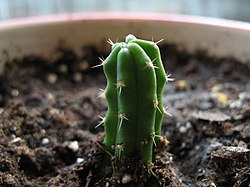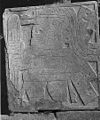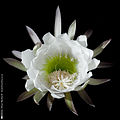Trichocereus macrogonus var. pachanoi
| San Pedro cactus | |
|---|---|

| |
| Echinopsis pachanoi in Hawaii | |
| Scientific classification | |
| Kingdom: | |
| (unranked): | |
| (unranked): | |
| (unranked): | |
| Order: | |
| Family: | |
| Genus: | |
| Species: | E. pachanoi
|
| Binomial name | |
| Echinopsis pachanoi (Britton and Rose) Friedrich and Rowley
| |
| Synonyms | |
|
Trichocereus pachanoi Britton & Rose | |
Echinopsis pachanoi (syn. Trichocereus pachanoi) — known as San Pedro cactus — is a fast-growing columnar cactus native to the Andes Mountains at 2,000–3,000 m (6,600–9,800 ft) in altitude.[1][2] It is found in Argentina, Bolivia, Chile, Ecuador and Peru,[3] and it is cultivated in other parts of the world. Uses for it include traditional medicine and traditional veterinary medicine, and it is widely grown as an ornamental cactus. It has been used for healing and religious divination in the Andes Mountains region for over 3,000 years.[4] It is sometimes confused with its close relative, Echinopsis peruviana (Peruvian torch cactus).
Taxonomy
Echinopsis pachanoi is known by many names throughout South America such as Achuma, Huachuma, Wachuma, Aguacolla, Hahuacollay, or Giganton.
Description
Echinopsis pachanoi is native to Ecuador and Peru. Its stems are light to dark green, sometimes glaucous, with a diameter of 6–15 cm (2.4–5.9 in) and usually 6–8 ribs. The whitish areoles may produce up to seven yellow to brown spines, each up to 2 cm (0.8 in) long; the plant is sometimes spineless.[2] The areoles are spaced evenly along the ribs, approximately 2 cm (0.8 in) apart.[3] Echinopsis pachanoi is normally 3–6 m (10–20 ft) tall and has multiple branches, usually extending from the base.[2] The tallest recorded specimen was 12.2 metres (40 ft) tall.[3] White flowers are produced at the end of the stems; they open at night. The flowers are large, around 19–24 cm (7.5–9.4 in) long with a diameter of up to 20 cm (7.9 in). There are black hairs along the length of the tube leading to the flower. Oblong dark green fruits are produced after fertilization, about 3 cm (1.2 in) across and 5–6 cm (2.0–2.4 in) long.[2]
Traditional uses


Echinopsis pachanoi has a long history of being used in Andean traditional medicine. Archeological studies have found evidence of use going back two thousand years, to Moche culture.[5] Although Roman Catholic church authorities[who?] after the Spanish conquest attempted to suppress its use,[citation needed] this failed, as shown by the Christian element in the common name "San Pedro cactus" – Saint Peter cactus. The name is attributed[by whom?] to the belief that just as St Peter holds the keys to heaven, the effects of the cactus allow users "to reach heaven while still on earth."[6]
Alkaloids

The San Pedro cactus contains a number of alkaloids, including the well-studied chemical mescaline (0.21–1.8%), and also 3,4-dimethoxyphenethylamine, 4-hydroxy-3-methoxyphenethylamine, 3-hydroxy-4,5-dimethoxyphenethylamine, 4-hydroxy-3,5-dimethoxyphenethylamine, anhalonidine, anhalinine, hordenine, tyramine, and 3-methoxytyramine.[7]
Mescaline (3,4,5-trimethoxyphenethylamine) is a psychedelic drug and entheogen, which is also found in some other species of genus Echinopsis (i.e. Echinopsis lageniformis, Echinopsis peruviana, and Echinopsis scopulicola) and the species Lophophora williamsii (peyote).[8]
Anecdotal evidence suggests that the highest concentration of active substances is found in the layer of green photosynthetic tissue just beneath the skin.[3]
There are various mescaline extraction techniques, simple (simmering in water 5 to 7 hours) and complex (such as an acid-base extraction), the latter technique yielding a material with a significantly higher concentration of mescaline.
Cultivation
This section contains instructions, advice, or how-to content. (March 2012) |

USDA Hardiness Zones: 8b to 10[9]
Soil acidity: Alkaline[10]
The San Pedro cactus is very easy to grow in most areas. Because it grows naturally in the Andes Mountains at high altitude and with high rainfall, it can withstand temperatures far below that of many other cacti. It requires fertile, free-draining soil. They average half a meter per year of new growth.[3] They are susceptible to fungal diseases if over-watered, but are not nearly as sensitive as many other cacti, especially in warm weather. They can be sunburned and display a yellowing chlorotic reaction to overexposure to sunlight.
In winter, plants will etiolate, or become thin, due to lower levels of light. This may be problematic if the etiolated zone is not sufficiently strong to support future growth as the cactus may break in strong winds.
Propagation from cuttings
Like many other plants, Echinopsis pachanoi can be propagated from cuttings. The result is a genetic clone of the parent plant.[10] For example, the top 15 cm end of a cactus column can be cut off with a knife, then the cutting can be left to dry for about two weeks in the shade, or in a dry place. This is so that the surface of the cut end dries out like paper forming a seal to keep out microbes such as fungi and bacteria. The cutting can then be dipped in rooting hormone (optional, but effective) and planted on the surface of or buried to a maximum of 2.5 cm deep in good propagation media mixed with some sand and perlite. The sand and perlite will ensure that the media will drain and not stay too wet. The cutting is kept in the shade or indirect sunlight, so that the root system can develop and the cactus does not grow too thinly. It is best to withhold watering for the first week or two. The moisture in the media alone is sufficient to begin the formation of adventitious roots. Lightly tug on the cactus to check for root formation. Do not attempt to pull the cactus all the way out of the soil to examine it. You will damage any roots that may have already begun to form. After about six months, significant roots will have formed and the cutting can be repotted in the same type of medium.[10]
Log method
A long cactus column can be laid on its side on the ground (like a log), and eventually roots will sprout from it and grow into the ground. After time, sprouts will form and cactus columns will grow upward out of it along its length.[10]
Propagation from seed

The seeds are quite easy to germinate and grow. Their main requirements consist of high humidity levels, free-draining soil mix, and enough (but not too much) water, light, and nutrition. There are a number of commonly-used methods that satisfy these requirements and the choice of a particular method depends mainly on the scale of the cultivation operation.

For soil, use coarse sharp sand (sieved river sand). Some people also find coir or peat, or mixtures, to be effective. The soil can be sterilized by cooking it in an oven on high for 1–2 hours. Sterilization will be most effective if the sand is moist. If one is available, an autoclave would also be useful at this point.

Some people find sterilization to be unnecessary. This may depend on other factors. The soil is placed into trays (which can be sanitized with bleach beforehand if desired) and the seeds planted into it (when the soil has cooled). The seeds should be only just below the surface (i.e. two or three sand grains over them). The trays now need to be kept in a humid environment. This may be achieved by the use of plastic bags, glass plates, or greenhouses, depending on scale. About 25 °C. is a good temperature for germinating the seed, with 33 °C during the day as a maximum temperature and 15 °C as a nighttime minimum temperature.[11] Seeds usually germinate within two weeks to a month, but sometimes come up after several months.

The seedlings stay in the humid environment for several months. During this time they must be continually checked for water and nutrient requirements, and fungal pathogens. Ensure the soil stays moist, but not overly wet. Nutrients can be provided with a liquid fertilizer at 1/8 strength whenever growth rate slows down. Fungi can be killed with a sulfur- or copper-based fungicide. There have been some reports of seedlings responding negatively to these treatments; so be very cautious with the amount used. There is some evidence that garlic is also an effective fungicide.[citation needed]
If germinating seeds in cold weather, a heat mat and fluorescent light can be used. These should be set on a timer to mimic normal diurnal temperature cycles for germination but can be left on permanently for faster growth once all the seeds have sprouted. One good method for growing cacti seedlings using this setup is to germinate them in late winter and have them ready to go outside by spring as temperatures and light levels are increasing.
Legality
In most countries it is legal to cultivate the San Pedro cactus, but in countries where possession of mescaline and related compounds is illegal and highly penalized, cultivation for the purposes of consumption is most likely illegal and also highly penalized. This is the case in the USA, Australia, Canada, Sweden, Germany, New Zealand, and Norway, where it is currently legal to cultivate the San Pedro cactus for gardening and ornamental purposes, but not for consumption.
United States
In the United States, mescaline was made illegal in 1970 by the Comprehensive Drug Abuse Prevention and Control Act. It was prohibited internationally by the 1971 Convention on Psychotropic Substances[12] and is categorized as a Schedule I hallucinogen by the CSA. Mescaline is only legal for certain natives (such as those involved in the Native American Church). "Mescaline is a controlled substance, U.S. code of Federal Regulations, title 21 part 1308.11(1987)."[13] Penalties for manufacture or sale can be as high as five years in jail and a fine of $15,000, with a penalty of up to one year and fine of $5000 for possession. The possession and cultivation of the San Pedro cactus per se for decorative purposes is legal, but, if one were to extract the mescaline from the cactus, then the penalties for mescaline would apply.
Gallery
See also
- Ayahuasca
- Crystal Fairy & the Magical Cactus
- Entheogen
- List of psychoactive plants
- Peruvian Torch cactus
- Peyote
References
- ^ Rätsch, Christian (2002). Enzyklopädie der psychoaktiven Pflanzen. Botanik, Ethnopharmakologie und Anwendungen. Aarau: AT-Verlag. p. 15. ISBN 3-85502-570-3.
- ^ a b c d Anderson 2001, p. 276.
- ^ a b c d e Visionary Cactus Guide, Erowid.org, retrieved 2012-10-24
- ^ Bigwood, Jeremy; Stafford, Peter J. (1992). Psychedelics encyclopedia. Berkeley, CA: Ronin Pub. pp. 118–9. ISBN 0-914171-51-8.
{{cite book}}: CS1 maint: multiple names: authors list (link) - ^ Bussmann RW, Sharon D (2006). "Traditional medicinal plant use in Northern Peru: tracking two thousand years of healing culture". J Ethnobiol Ethnomed. 2 (1): 47. doi:10.1186/1746-4269-2-47. PMC 1637095. PMID 17090303.
{{cite journal}}: CS1 maint: unflagged free DOI (link) - ^ Anderson, Edward F. (2001). The Cactus Family. Pentland, Oregon: Timber Press. ISBN 978-0-88192-498-5.
{{cite book}}: Invalid|ref=harv(help) pp. 45–49. - ^ Crosby, D.M.; and McLaughlin, J.L. (Dec 1973). "Cactus Alkaloids. XIX Crystallization of Mescaline HCl and 3-Methoxytyramine HCl from Trichocereus panchanoi" (PDF). Lloydia and the Journal of Natural Products. 36 (4): 416–418. PMID 4773270. Retrieved 13 December 2013.
{{cite journal}}: CS1 maint: multiple names: authors list (link) - ^ Anderson 2001, pp. 44–49.
- ^ "San Pedro Cactus (Echinopsis pachanoi)". desert-tropicals.com. Retrieved 2008-02-23.
- ^ a b c d "What if the cut end doesn't dry properly and starts to mold" (PDF). Retrieved 2012-02-07.
- ^ "Growing Cacti from Seed". www.plot55.com. Retrieved 2008-02-23.
- ^ "List of psychotropic substances under international control" (PDF). Retrieved 2007-11-28.
- ^ "Turbinicarpus Information Exchange - Alkaloids and why Turbinicarpus sp. contain them". mfaint.demon.co.uk. Retrieved 2008-02-23.







